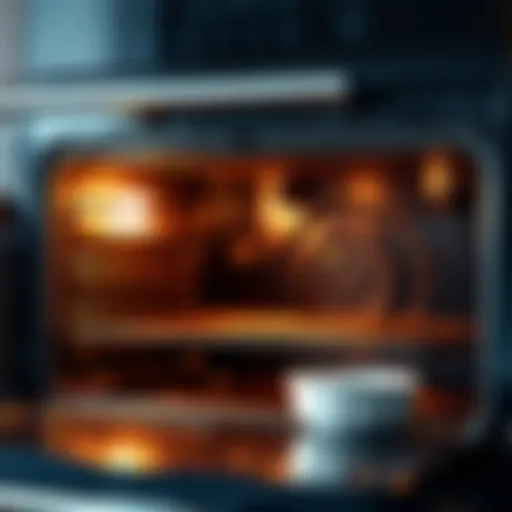Understanding Good Copper Pans for Cooking
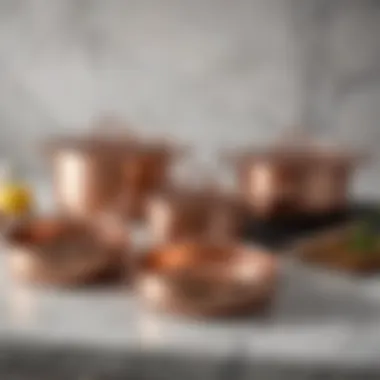

Intro
Copper pans have a strong foothold in the culinary world. This isn't just due to their striking reddish hue but also their remarkable ability to conduct heat. Chefs particularly favor them for their precision while cooking. It’s not just about aesthetics; there is a science behind why these pans are a staple in kitchens ranging from household to professional establishments.
As we delve deeper into the nuances of copper pans, it becomes increasingly clear that understanding their properties and proper usage can significantly enhance one’s culinary adventures. We'll navigate through key aspects such as defining high-quality copper pans, discussing their benefits and drawbacks, and elucidating effective maintenance practices. By the end of our exploration, both culinary novices and seasoned cooks can gain valuable insights into the role copper pans can play in elevating their cooking experience.
Intro to Copper Cookware
Copper cookware holds a unique place in both culinary history and modern kitchens, cherished for its remarkable characteristics. This section delves into the foundational aspects of copper pans, providing a critical understanding of why they are a staple among cooks. From the historical significance to their practical applications today, the advantages and considerations surrounding copper cookware will be explored in detail.
Historical Significance of Copper
Copper has been a favored material for cookware since ancient times, with evidence of its use dating back thousands of years. Renowned for its natural conductivity, it allowed for a more even heat distribution, a quality that was not plentiful in other materials available. This made copper particularly valuable in the kitchens of aristocrats and taverns alike. Ancient civilizations, such as the Romans and Egyptians, recognized its utility and aesthetic appeal.
In the days of yore, skilled artisans crafted pots and pans with intricate designs. These pieces weren't merely functional; they were often displayed as symbols of status and wealth. In fact, some historical accounts suggest that cooking in copper was seen as a mark of sophistication, where culinary mastery was showcased in the presentation of beautifully crafted cookware. Today, this legacy continues to influence culinary practices, sustaining copper's reputation.
Copper in Modern Kitchens
Fast forward to the present, and copper cookware is enjoying a renaissance among professional chefs and homecooks. Its properties remain relevant, as modern culinary techniques demand precision, adaptability, and style. With the increasing popularity of open kitchens and food shows, the aesthetic allure of copper pan’s gleams against the backdrop of contemporary kitchen designs.
Moreover, culinary experts often champion copper for its exceptional responsiveness to heat. This feature means that temperature adjustments can be made almost instantaneously, a critical aspect when preparing delicate sauces or confections. In addition, when paired with steel or other materials, copper pans can provide the perfect balance of heat conductivity’ and durability.
However, it also comes with certain considerations regarding usage and maintenance. With its reactivity to acidic foods, a good understanding of how to care for copper pans is essential for achieving the best culinary results.
In summary, the significance of copper cookware transcends mere utility. It embodies a blend of historical legacy and modern practicality, offering a rich narrative that goes beyond cooking. When jumping into the intricacies of good copper pans, appreciating this duality enhances the understanding and appreciation of their role in both professional and amateur kitchens.
Characteristics of Good Copper Pans
When it comes to cookware, the characteristics of good copper pans stand out as pivotal factors influencing both performance and the culinary experience. These qualities are not just for aesthetics; they significantly affect how meals are prepared and how flavors are developed. Grasping these characteristics fosters an understanding of why copper is often hailed as a top-tier material in the kitchen.
Heat Conductivity
One of the most remarkable traits of copper pans is their superior heat conductivity. Unlike stainless steel or cast iron, copper heats quickly and evenly, meaning food can be cooked precisely at the required temperature.
This quality is especially beneficial for delicate sauces or dishes that require fine temperature control, for instance:
- Flambéing: The quick response to heat allows for dramatic culinary techniques with a level of control.
- Chocolate melting: Ensures that the delicate chocolate doesn’t burn as it can in less conductive pans.
"Copper is the secret ingredient to a chef’s kitchen!" This quote sums up the invaluable role of heat conductivity when preparing gourmet meals.
Improper heating can ruin a dish, where ingredients scorch or fail to reach the necessary doneness. The responsive nature of copper helps alleviate these issues, providing a consistent cooking experience.
Weight and Balance
The weight and balance of copper pans play a crucial role in kitchen dynamics. Generally, these pans are heavier than aluminum but lighter than cast iron. This balance aids in:
- Control while cooking: A well-balanced pan provides a comfortable grip, facilitating easy movement and flipping of ingredients.
- Stability on the stovetop: Ensures pans remain in place, reducing the risk of spills or accidents.
It's worth noting that weight can be a subjective preference. Some cooks might favor a lighter pan for quick sautéing, while others may prioritize heft for stability when cooking on high heat. Either way, a copper pan’s design supports an intuitive cooking experience, helping maintain stability without compromising maneuverability.
Aesthetic Appeal
Finally, let’s not overlook the aesthetic appeal of copper pans. The gleam of polished copper not only catches the eye but also adds a touch of elegance to any kitchen décor. They invoke a sense of nostalgia, harkening back to a time when cooking was an art, and each piece of cookware told a story.
Consider these points:
- Visually striking: Copper pans often become the centerpiece of kitchens, inspiring creativity and a love for cooking.
- Versatile design: Available in various finishes and design styles, this cookware can match nearly any theme, from rustic to contemporary.
However, it’s essential to remember that their beauty can be somewhat deceiving. Just as a stunning painting may require a proper frame, copper pans require the appropriate care to maintain their charm. Without regular maintenance, they can tarnish and lose their luster. Still, the aesthetic brings joy and passion into the culinary experience, making them a worthy addition to any kitchen arsenal.
Ultimately, understanding these characteristics illuminates why copper pans are so revered in culinary circles. Their unique benefits enhance the cooking process and make them delightful tools for crafting exquisite meals.
Advantages of Using Copper Pans
Copper pans are more than just a pretty face in the kitchen; they pack a punch with several advantages that make them a prized possession for anyone serious about cooking. Focusing on precision, durability, and versatility, we uncover the reasons why these pans deserve a spot in both professional and home kitchens alike.
Precision Cooking
One of the most significant benefits of copper pans is their exceptional heat conductivity. Copper heats up quickly and evenly, allowing for precise control over cooking temperatures. This is crucial for techniques like sautéing, where a fine balance of heat can mean the difference between perfectly caramelized onions and an unpleasant burnt mess.
Think of it as the secret weapon for culinary artisans. When working with delicate tasks such as melting chocolate or tempering eggs, a swift response to your heat adjustments can lead to perfect outcomes.
"If you want to achieve that professional touch in your dishes, mastering heat control with a copper pan is a game changer."
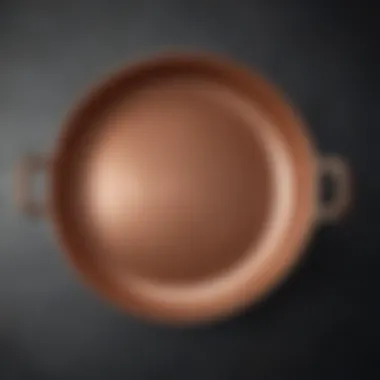

Durability and Longevity
Investing in good quality copper pans means investing in a kitchen companion that can stand the test of time. While they require a bit more care, their resistance to warping, scratching, and deterioration makes them endure longer than their non-copper counterparts.
Copper pans are often lined with stainless steel or tin, which not only adds a layer of protection against reactions with food but also helps maintain their shining appearance. When maintained properly, a copper pan can serve you for decades, improving with age, much like a fine wine. Regular upkeep, including proper cleaning and polishing, ensures they stay in peak condition.
Versatility Across Cooking Techniques
Copper pans are not a one-trick pony; their design lends itself well to a variety of cooking methods. Whether it’s frying, braising, or even baking, these pans adapt well. For instance:
- Sautéing: The even heating provides a perfect environment for vegetables to cook without losing their nutrients.
- Braising: Copper pans can handle simmering liquids beautifully, creating an ideal habitat for tender meats.
- Baking: The quick response to temperature changes can yield superb results when you need even baking, like in sauces or pastries.
Having a set of copper pans means one can experiment with various culinary techniques on a single surface, achieving results that might not be possible with standard cookware.
In summary, the advantages of using copper pans fulfill the most demanding expectations for cooks, making them excellent choices for creating flavorful dishes with optimal control and longevity.
Disadvantages and Considerations
While copper pans have found their place in the kitchens of many culinary enthusiasts, they come with a share of disadvantages that merit discussion. Understanding these concerns is crucial for anyone considering the leap into copper cookware. Not only does it help in managing expectations, but it also ensures informed choices, which can ultimately lead to smoother cooking experiences.
Reactivity with Certain Foods
One notable downside of copper cookware is its reactivity with acidic ingredients. Many food items, like tomatoes, vinegar, and citrus fruits, can interact with copper, potentially leading to off-flavors and even copper leaching into the food. This reaction may not be immediately harmful in small amounts, but it can alter the taste significantly.
For this reason, many high-quality copper pans come lined with materials such as stainless steel or tin. This lining helps prevent any reactivity, allowing you to enjoy the benefits of copper without compromising the integrity of your dishes. If you're preparing meals that include acidic ingredients, it’s wise to double-check the type of lining your copper cookware has.
Maintenance Requirements
Maintaining copper pans can be a bit of a chore compared with other materials. Unlike stainless steel or non-stick options, which are often marketed as low-maintenance, copper requires a bit more TLC. Regular cleaning is essential to keep those pans sparkly and to preserve their aesthetic appeal.
To maintain copper's luster, it’s recommended to hand wash with a gentle detergent rather than tossing them in a dishwasher. Using a copper cleaner or a mixture of lemon juice and baking soda can effectively remove tarnish.
Additionally, copper pans can develop patina over time, which may be appealing to some but not to everyone. People need to consider if they’re ready to invest the time for proper upkeep before committing to copper cookware.
Cost Factors
Price is another significant consideration when it comes to copper pans. High-quality copper cookware often comes with a hefty price tag, sometimes making it a considerable investment. While cheaper options are available, they often compromise on things like thickness and quality of lining, which can affect performance.
When you're investing in cookware, think about how often you'll use it and the types of cooking you do. Well-maintained copper pans can last a lifetime and may even become family heirlooms, justifying the initial cost. However, for someone who cooks infrequently, the expense might not be worth it.
In summary, while the luxurious appeal and cooking properties of copper pans are undeniable, it’s essential to weigh their disadvantages carefully. By understanding reactivity issues, maintenance requirements, and cost factors, cooks can make more informed decisions about integrating copper cookware into their culinary arsenal.
"Good cooking is one part recipe and many parts consideration."
How to Evaluate Good Quality Copper Pans
When it comes to copper pans, knowing how to assess quality can mean the difference between a kitchen essential and an overpriced piece of metal. Evaluating good quality copper pans is not just about looking for shiny exteriors, but digging deeper into aspects like materials, construction, and even brand reputation. This section breaks it down, laying out the critical factors that every cook should consider before making a purchase, ensuring that the investment enhances their culinary practices.
Materials and Construction
The core of any good cookware lies in its materials and the way it’s constructed. Copper pans are typically made using various alloys or linings, and understanding these components can greatly affect performance.
Firstly, the thickness of the copper is crucial. A pan with a hefty gauge ensures even heat distribution and minimizes warping. Generally, those who are in-the-know often recommend looking for copper that is at least 2.5mm thick. Thin copper isn’t worth its weight, as it can lead to burnt spots and uneven cooking, leaving your sauces and soufflés in a less-than-stellar state.
Next, consider the lining. Most copper pans come with a lining to prevent direct contact between food and copper, which can react unfavorably with acidic ingredients. High-quality options often have linings made of stainless steel or tin. Stainless steel linings are stronger and more durable, making them a popular choice among professional chefs. Tin, although traditional, tends to wear down over time but offers a unique benefit: it can be easily re-tinned.
Materials Checklist:
- Gauge of copper (thickness matters)
- Type of lining (tin vs. stainless steel)
- Overall construction (look for riveted handles or solid seams)
Taking a closer look at the craftsmanship is also vital. Well-made pans have even seams and smooth finishes that not only look nice but also enhance functionality. It’s worth getting a feel for the handle; it should be sturdy but not cumbersome, allowing for a comfortable grip.
Brand Reputation
Sometimes, a name can carry weight in the world of cookware. When it comes to brand reputation, established names in copper cookware often use high-quality materials and pay attention to the construction of their products. Brands like Mauviel, All-Clad, and Falk often earn respect due to their consistent quality and the craftsmanship that goes into each piece.
Shopping based on brand alone may seem simplistic, but there’s merit in doing a little homework. Most renowned brands have a heritage rooted in culinary craftsmanship, and they usually provide customer support along with warranties.
On platforms like Reddit or food blogs, seeking opinions on specific brands can also provide insights that mere specifications might not reveal. Customer reviews often spotlight durability, heat distribution, and long-term performance, key factors that new buyers might overlook.
Considerations for Brand Reputation:
- Longevity and history of the brand
- Customer service and warranty offerings
- Reviews and experiences from other cooks
"The right tool can turn cooking from a chore into a delightful experience. Choose wisely!"
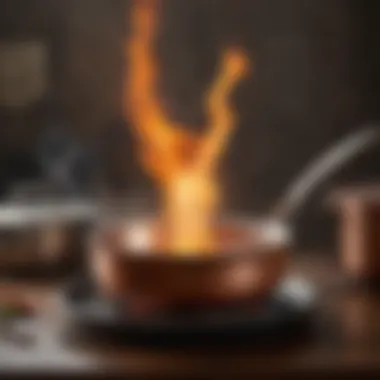

When integrating copper cookware into your culinary arsenal, prioritize quality over flashiness. The difference will be apparent the first time you sauté onions or whip up a delicate sauce.
Maintaining Copper Cookware
Maintaining copper cookware is crucial for those who wish to enjoy its numerous benefits for many years. While its stunning aesthetics and unmatched heat conductivity make copper pans a prized kitchen staple, proper care is essential to prevent tarnishing and ensure prolonged functionality. If neglected, copper can lose its luster and even develop discoloration, making maintenance not just a chore but an art in itself.
Cleaning Techniques
Keeping your copper pans clean is the first step in ensuring their longevity. Unlike stainless steel, copper requires a more gentle touch. Here are some effective techniques to consider:
- Warm Soapy Water: Begin by soaking your pan in warm soapy water. This helps lift grime without scratching the surface. Use a non-abrasive sponge to gently scrub away any residue.
- Baking Soda Paste: For tougher stains, make a paste using baking soda and water. Gently rub this mixture onto the stained area using a soft cloth or sponge, then rinse thoroughly. This natural cleaner works wonders without harming the copper.
- Vinegar and Salt: A combination of vinegar and salt can restore shine. Apply this solution to the tarnished areas and gently rub. However, avoid letting it sit for too long to prevent any potential damage.
"A little care goes a long way! Regular cleaning not only preserves the beauty of your copper cookware but also enhances its cooking capabilities."
By adhering to these practices, you can maintain the appearance and functionality of your copper pans without too much hassle.
Polishing Methods
After cleaning, the next step is polishing. This process ensures your copper cookware maintains its brilliant shine. Here are a couple of methods that work effectively:
- Commercial Copper Polish:
- Homemade Polishing Solution:
- Many products on the market cater specifically for copper. Just follow the instructions on the label, and you’ll have cookware that looks as good as new. Be sure to rinse thoroughly afterward to avoid any residue.
- Mix equal parts of vinegar, flour, and salt to create a paste. Apply this thoroughly over the copper surface, leaving it for several minutes before rinsing off and drying. The acid will help lift tarnish while the flour provides gentle abrasion.
Polishing not only restores shine but aids in cleaning as well, which is a win-win for copper cookware owners. Regular polishing allows copper grains to reflect light, giving your cookware a unique glow that complements any kitchen décor.
Maintaining copper cookware might seem daunting at first glance, but with these cleaning and polishing methods, it can be a fulfilling part of your culinary routine. It allows you to strike a balance between keeping your kitchen equipment in excellent condition while enjoying the remarkable features that copper offers.
Cooking Techniques Optimal for Copper Pans
Copper pans are not just a pretty face in the kitchen. They excel at various cooking techniques, making them essential for both aspiring and experienced chefs. Understanding the methods that best suit copper cookware can significantly enhance your cooking experience. This section delves into the two primary techniques optimal for using copper pans: sautéing and frying, along with braising and simmering.
Sauteing and Frying
Sautéing and frying are where copper pans truly shine. Their exceptional heat conductivity ensures even cooking, which is crucial when you need to achieve that perfect sear on meats or a delicate caramelization of vegetables. Copper pans heat up quickly and respond promptly to temperature changes, allowing for greater control over the cooking process.
When sautéing, the key is to get that pan hot enough. A well-heated copper pan will bring out the natural flavors of your ingredients, creating a delightful dish. You might want to remember that a gentle toss or turn can make all the difference. Try using a light splash of oil, along with butter, to create a rich flavor while preventing your food from sticking. This combination helps in achieving that golden brown exterior, a hallmark of successful sautéing.
Frying, on the other hand, benefits from the thermal efficiency of copper. When deep frying, the oil temperature is critical. The ability of copper to heat evenly makes it an ideal choice for frying, whether it's crispy potatoes or a savory chicken. Moreover, because of its responsiveness to heat, you can maintain consistent oil temperatures, preventing the greasy texture that often ruins a good fry. While frying, be cautious about overloading your pan, as this can cause oil temperatures to drop, leading to soggy results instead of crispy morsels.
Copper pans are like the race cars of cookware; they respond quickly to your commands, making them perfect for high-energy cooking.
Braising and Simmering
Switching gears to braising and simmering, copper pans also hold their own remarkably well. Their ability to maintain steady, low temperatures is unparalleled. When braising tougher cuts of meat, you want even, gentle heat to break down the fibers and transform the dish into one that is tender and flavorful. Copper pans distribute this heat beautifully, allowing for effective slow cooking.
Simmering, for sauces or stews, benefits from copper's heat retention properties. When simmering sauces, the goal is to coax flavors without boiling them away. Copper pans provide that consistent warmth, ensuring your sauce reduces perfectly while keeping an eye on that texture. Too much agitation can lead to undesirable results, and a well-crafted copper pan can help maintain that delicate balance.
In summary, whether sautéing, frying, braising, or simmering, the unique characteristics of copper cookware enhance many cooking techniques. The responsiveness and heat distribution of these pans not only elevate the cooking process but also result in beautifully cooked dishes. Thus, investing some time to understand how to utilize these pans effectively will yield delicious rewards, making every culinary endeavor enjoyable.
Comparing Copper Pans with Other Materials
When it comes to culinary tools, not all cookware is created equal. Each material brings its unique qualities to the table, shaping not just our cooking but our entire experience in the kitchen. In this section, we will look closely at how copper pans stack up against two popular alternatives: stainless steel and non-stick options. Understanding these differences is crucial for cooks at any level who aim to make informed choices about their cookware.
Stainless Steel
Stainless steel, often deemed the workhorse of the kitchen, provides its own set of advantages and drawbacks. Its resistance to rust, staining, and corrosion certainly makes it appealing. Unlike copper, stainless steel pans require no special treatment or maintenance. You can toss them in the dishwasher without a second thought.
However, heat distribution can be problematic. Stainless steel tends to have hot spots, especially if you don’t invest in those with a copper or aluminum core that improves heat conductivity. While its durability is commendable, foods can stick to the surface if you’re not careful about pre-heating or using adequate oil or butter.
Key features of stainless steel include:
- Durability: Can withstand high heat and doesn’t chip, like non-stick coatings.
- Ease of Care: Simple to clean; doesn’t require special care like copper does.
- Non-reactive: Safe for cooking acidic foods like tomatoes and vinegar.
But here’s the rub: if you’re after precise temperature control for delicate sauces or frying, stainless steel might just leave you feeling a bit left out in left field.
Non-Stick Options
Non-stick pans, often cloaked in Teflon or ceramic coatings, promise the cooking world a quick and easy cleanup. The appeal lies in their ability to prevent food from sticking, making them especially favored for cooking eggs or pancakes. On the surface, this sounds great, right? No more scrubbing away burnt remains.
But there’s a trade-off. Non-stick materials can have a shorter lifespan. The coatings tend to degrade and scratch over time, leading to chipping and peeling, potentially compromising food safety. Plus, they don’t offer the same responsiveness to heat changes as copper pans.
Here are a few points to weigh up:
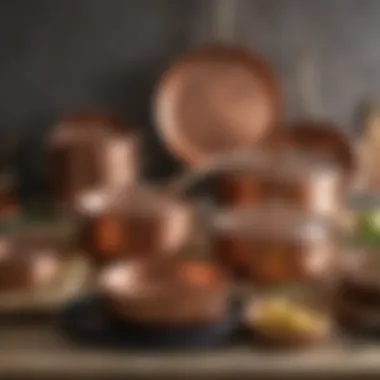

- Convenience: Cooking and cleanup are effortless; very beginner-friendly.
- Lightweight: Easy to handle, especially for people who don’t want to wrestle with a heavy pan.
- Less Oil Needed: Ideal for those watching their fat intake.
Despite these benefits, they lack the heat responsiveness that copper offers. If a cook aims to achieve a perfect sear or gain deep flavors through browning, then non-stick might not do the trick.
All in all, when comparing copper pans with stainless steel and non-stick options, each has its merit. It's essential to consider your cooking style and what you aim to achieve in the kitchen. So what’s the bottom line? If you’re looking for precision, responsiveness, and durability, copper pans are hard to beat. However, for simplicity and less fuss, you might lean toward stainless steel or non-stick products. The choice ultimately resides in the culinary goals you set for yourself, making it an essential conversation before filling your cupboards with new gadgets.
"Choosing cookware is like picking a partner in the kitchen; make sure it complements your style while also being reliable for the long haul."
Understanding these distinctions can lead to more informed choices in your culinary endeavors, ensuring you’ll have the right tools for the right tasks.
Safety Considerations When Using Copper Pans
When it comes to cooking, safety is paramount — especially when handling cookware like copper pans, which, while exquisite and highly effective, come with their own set of considerations. Being mindful of these factors ensures not only a pleasant cooking experience but also protects your health and well-being.
Handling Hot Cookware
Copper pans are known for their excellent heat conduction. However, this means that they heat up quickly and can retain heat for an extended period. As such, the first rule of thumb when cooking with these pans is to always use pot holders or oven mitts, no matter how momentarily you think you’ll be lifting them. Even a brief lapse in caution can lead to burns.
When placing a hot copper pan down on the countertop or table, always ensure that it is on a trivet or heat-resistant surface to avoid damaging the underlying material. Letting a hot pan rest on a wooden surface, for instance, can ruin both the pan and the surface. Furthermore, if you have kids around, be mindful of where you place the strap since those littles ones can be curious and quick!
It’s also vital to maintain a clear workspace. An organized area minimizes the risk of bumping into things, which could cause spills or accidents, especially with hot liquids.
Using Linings Appropriately
Copper cookware typically has a lining, often made of stainless steel or tin, to prevent the metal from reacting with certain foods. It’s crucial to understand this aspect to ensure proper use and longevity of your pans. Using unlined copper cookware for acidic foods like tomatoes or vinegar can cause harmful reactions, leading to the leaching of copper ions into the food.
Regularly inspect the lining for any signs of wear or damage. If you see scratches or tarnishing on the inside, it might be time to get it re-lined or replaced. Using utensils made from wood or silicone can help prevent scratches while cooking.
Another point to consider is temperature control; extreme heat can damage the lining, especially tin. So, keeping the heat at medium or low during cooking can go a long way in preserving the integrity of the cookware.
"Safety in the kitchen isn’t just a precaution; it’s a fundamental part of the culinary experience." - Culinary Expert
Navigating the world of copper pans can be a bit daunting at first, but by keeping safety at the forefront of the experience, you can enjoy the rich flavors and aesthetics that copper cookware brings to your kitchen.
Culinary Innovations Featuring Copper Cookware
Copper cookware has carved out a niche not just in traditional cuisines but also in the realm of innovation. Modern chefs and food enthusiasts are continually exploring the potential of copper pans beyond their classic appeal. The shifts in culinary trends and the rise of innovative cooking techniques underscore the relevance of copper in today’s kitchens.
Modern Recipes Utilizing Copper
When thinking about cooking with copper pans, one often envisions sautéed vegetables or delicate sauces. However, contemporary cooking has seen a surge in creative applications.
One such dish is a copper-roasted beet salad, where the high conductivity of copper allows for even cooking and caramelization. The beets roast beautifully, developing a soft interior while maintaining a slightly crisp exterior. Chefs often complement this with a tangy vinaigrette, which gets accented by the rich, earthy flavors of the roasted beets. This dish epitomizes how copper can bridge the gap between traditional and modern cooking.
Another compelling use of copper is in making candy. A perfectly heated copper pot is essential for achieving the right sugar crystal formation. The precision offered by copper pans allows for flawless execution in making caramel or toffee, turning culinary enthusiasts into home confectioners. One can’t underestimate how the aesthetics of the copper finish brings an artistic touch to any kitchen display.
Key Benefits of Using Copper in Modern Recipes:
- Temperature Control: The quick heat response helps in achieving accurate temperature settings crucial for delicate dishes.
- Visual Appeal: Copper not only enhances cooking outcomes but also elevates the presentation, making dishes visually stunning.
- Promotes Craftsmanship: Using copper allows chefs to engage more deeply with the cooking process, often leading to a more enriching culinary experience.
Celebrity Chef Insights
When it comes to leveraging copper in culinary innovations, many renowned chefs have endorsed its usage. For instance, celebrity chef Thomas Keller champions copper pans for their precision, particularly in sauces. He often quotes, "Copper is the ultimate conductor of heat—it's why pros use it."
Moreover, Heston Blumenthal, a pioneer in molecular gastronomy, employs copper pans in his renowned restaurant to achieve specific texture and temperature controls. He states that copper not only impacts flavor profiles but also significantly influences the chemistry of the ingredients, thereby unlocking new dimensions in culinary creations.
As we look at these insights, it becomes clear that copper cookware is much more than a stunning kitchen accessory. It has become an integral element in the exploration of new cooking techniques and flavor development.
"In the hands of a skilled chef, copper cookware transforms basic ingredients into culinary masterpieces."
Emphasizing the notion that culinary innovation thrives on the use of quality tools, the perspectives of these chefs reinforce the practical benefits of integrating copper into daily cooking. With deep-rooted traditions meeting modern methodologies, copper cookware continues to uphold its relevance in kitchens around the world, inspiring a new generation of culinary aficionados.
Epilogue
When it comes to culinary tools, the significance of copper pans cannot be overstated. They embody a blend of elegance, functionality, and tradition that appeals to both professional chefs and home cooks. As this article has demonstrated, the characteristics of good copper pans elevate cooking experiences in several ways. Whether it's the unparalleled heat conductivity that ensures even cooking or the aesthetic allure that makes your kitchen shine, copper pans are worthwhile investments.
It's worth noting that while copper pans offer many benefits, they are not without their challenges. The potential for reactivity with certain foods and the necessary upkeep can give some cooks pause. However, these factors should not deter culinary enthusiasts from diving into the world of copper cookware. Instead, they should encourage informed decision-making regarding usage and maintenance.
"In the kitchen, tools matter as much as techniques. Copper pans can be a game changer — but understanding their quirks leads to mastery in the culinary arts."
Ultimately, the journey with copper pans is one of exploration. The trending recipes highlighted throughout this article provide a glimpse into modern applications, while insights from renowned chefs underscore the potential for creativity. For those willing to embrace both the beauty and intricacies of copper cookware, the rewards are manifold — precision, satisfaction, and an enriched culinary repertoire.
Final Thoughts on Copper Pans
Copper pans are not merely instruments; they are artifacts that encapsulate culinary history and innovation. Their ability to conduct heat optimally makes them indispensable for tasks ranging from delicate sauces to sautéing vegetables. As someone keen on culinary arts, investing in a well-made copper pan adds both functionality and aesthetic charm to your kitchen. In touching upon versatility, it’s clear that these pans can transition smoothly from stovetop to oven, adapting to various cooking techniques with ease.
Encouraging Culinary Exploration
The world of cooking is vast, and there's always something new to learn. Whether you are a budding chef or have been flipping pancakes since childhood, arise to challenge conventional recipes by integrating copper pans into your cooking ventures. Engage in experimentation, try your hand at traditional techniques, or infuse modern twists — the only limit is your imagination. Delve into copper-centric recipes, share experiences with fellow food lovers, and take inspiration from culinary trends.
Fuel your passion for cooking and encourage others to do the same. Explore forums on platforms like Reddit and culinary groups on Facebook to connect with like-minded individuals. Embracing copper pans should be seen as an invitation to deeper exploration in culinary skills, fostering creativity and refinement in every dish.





